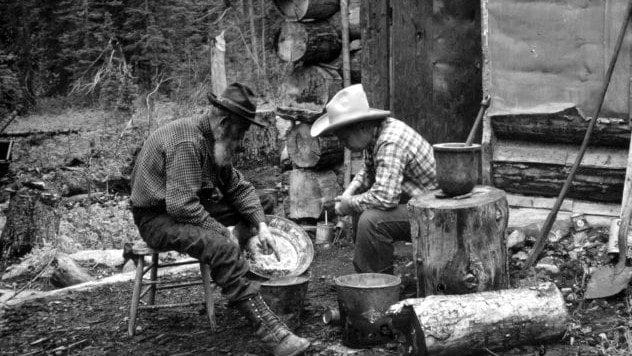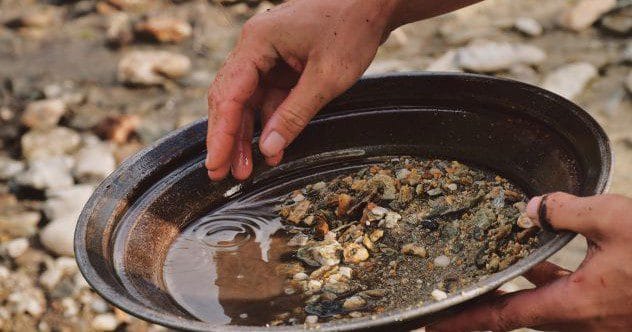You’ve probably learned about the California Gold Rush of 1849 in history class. It’s the most famous one, right? There were other gold rushes in the American West too, like the Black Hills Gold Rush, the Comstock Lode, and the Klondike Gold Rush. But most history books make it seem like the Intermountain West was the only place where gold rushes ever happened!
But that’s just not true. Gold rushes have occurred all over the world at different times. This list will explore the (mostly) forgotten gold rushes that didn’t make it into the history books. Get ready for some fascinating tales of fortune!
Cabarrus County, North Carolina (1803)
In 1799, a 12-year-old named Conrad Reed found a huge gold nugget on his family’s farm in North Carolina. His family wasn’t that impressed and used it as a doorstop! But in 1803, Conrad’s dad, John Reed, took it to a jeweler who offered him $3.50 (about $70 today). John took the deal.
Later, John realized how valuable the nugget was. He and some other farmers started searching for gold on their land. They quickly found a 28-pound gold nugget! News spread, and people came to the area looking for riches. Farmers would dig for gold in the winter after their crops were harvested.
By 1820, the shallow pits were empty. So, North Carolina farmers hired experienced miners from England to dig deeper mine shafts. For two decades, they found tons of gold, silver, and quartz.
By the mid-1840s, the minerals were gone, and the mining boom ended. But North Carolina still celebrates its gold rush history. The mascot of the University of North Carolina at Charlotte is the 49er, a tribute to the region’s mining past.
Habersham County, Georgia (1829)
While North Carolina’s gold rush was the first major mining operation in the U.S., Georgia’s 1829 gold rush got national attention. People in Habersham County (now White County), Georgia, found gold in the mid-1820s. By 1829, miners from all over came to get rich quick.
Thousands of people mined shallow pits and panned rivers for gold. This upset the local Cherokee people who had lived there for ages. Tensions grew between the Cherokee and the new settlers. In 1830, President Andrew Jackson signed the Indian Removal Act.
This act gave the land to the miners and ordered the Cherokee to be removed from their homes. This terrible event is known as the Trail of Tears and is one of the worst moments in American history. It all started because of a gold rush.
Gold Coast, Ghana (1471)
One of the most tragic gold rushes began in 1471 when Portuguese sailors landed in present-day Ghana. They found massive gold deposits along the River Pa. Over the next few decades, Europeans flocked to Ghana and mined the river until it was empty. They built castles and forts and called the area the Gold Coast.
Sadly, the gold mining wasn’t the worst part. The Portuguese and other Europeans were cruel to the African natives, using violence and slavery. The Dutch took over and were even more brutal, enslaving the locals to do their bidding. This led to the transatlantic slave trade.
Africans were shipped to the Caribbean, Brazil, and the U.S. The gold rush along the River Pa started it all. If the Portuguese hadn’t found so much gold, history might have been different.
Fraser River, British Columbia (1858)
In the 1850s, about 50,000 indigenous people lived in British Columbia’s Fraser River region. In 1856, a man from the Shuswap nation found gold in the Thompson River. They kept it secret for two years because they didn’t want white settlers to ruin their land. But in 1857, someone else found gold and sent a sample to San Francisco for testing.
When the test confirmed the gold, the rush was on. By 1858, the region’s population doubled as 50,000 white people flooded into the Fraser Canyon area. Many came from the depleted California gold fields and were determined to get rich. They aggressively mined every inch of the Fraser River.
The miners quickly overwhelmed the local villages. The Fraser Canyon War broke out in July 1858. The natives fought to protect their land, while the miners fought for gold. Neither side won, but the miners got the gold and left the area ruined. By the early 1860s, Canada annexed the region and called it British Columbia. The gold rush marked the end of a way of life.
Witwatersrand, South Africa (1884)
In 1884, people discovered small gold deposits near Johannesburg, South Africa. It took two years for the discoveries to be noticed. In June 1886, farmer George Harrison found a large gold deposit on Langlaagte Farm. Soon, the whole area was buzzing with activity.
Within a month, over 3,000 gold seekers rushed to Johannesburg. This was the start of the South African Gold Rush. Many tried panning for gold in rivers, but large-scale mining companies quickly took over. The Witwatersrand Gold Mining Company dominated the gold search.
The big mining companies were efficient and mined almost every last bit of gold. They pushed out the small-time miners. The gold fields dried up quickly, but not before the companies made huge fortunes. Johannesburg went from a small town to a major city and remains one of South Africa’s key urban centers.
Siberia (1838)
Russia is rich in minerals, especially in Siberia. A gold rush in 1838 solidified eastern Russia as a mining location. However, this gold rush was very different from others because it involved forced labor.
Locals found gold in the Yenisey River basin in 1838. The Russian government sent loyalists to control the mining operations. Instead of free men seeking gold, this Siberian gold rush used forced labor. Russian leaders brought in migrant workers from all over the region and northern China to mine the river’s banks under threat of violence.
The Chinese laborers got sick and died. So, the Russian government forced local peasants, drifters, and the poor to work in the gold fields. The conditions were terrible, but the labor produced tons of value for the wealthy Russians. This is one of the least-known gold rushes ever.
Tierra Del Fuego, Argentina (1883)

The strangest gold rush in history happened because of a shipwreck. In 1883, a French steamship, the Arctique, ran aground on the coast of Argentina’s Tierra Del Fuego. The sailors were in danger due to the bad weather and rough seas. A rescue expedition was sent, and they noticed gold flecks in the soil!
News of the discovery spread across Europe, and prospectors rushed to this remote region. Over the next three years, Tierra Del Fuego produced over 5,000 pounds of gold. However, the awful weather and terrain made mining dangerous. Many men died, while others became rich.
By the end of 1885, the mines were drying up, and the prospectors left. A few stayed to try to get more gold. Some small operations lasted into the early 20th century, but by the 1910s, almost every prospector had left Tierra Del Fuego for good. This was one of the most aggressive and unlikely gold rushes ever.
Bathurst, New South Wales (1851)
The Australian Gold Rush of 1851 in Bathurst was similar to the California rush. Locals found gold in a river in February 1851 and started mining. Soon, miners came from all over Australia and the world, including Germany and England. They wanted to get rich in Australia.
Over half a million miners came to Bathurst. The locals called them “diggers” and saw them as annoying or even a threat. The relationship between the landowners and the miners was difficult.
Unfortunately, there wasn’t as much gold in Bathurst as in other places. Most miners left without getting rich. A few settled down and became part of Australian culture. Today, their descendants still live in the region, and the gold rush is a point of pride for Australia.
Bulolo, Papua New Guinea (1922)
In 1852, gold was discovered in Bulolo, Papua New Guinea. Papuan locals had been using gold in their pottery for centuries, but it wasn’t until 1852 that white men found the gold in the hills.
It took almost 70 years for explorers to reach the area and start mining. After World War I, Australia gained control of German New Guinea. Australian colonists showed up to begin prospecting. By 1922, the Australian government legalized prospecting in New Guinea, and the rush was on.
Mining magnate Cecil John Levien bought miner’s rights around Bulolo. He found the gold fields and partnered with other prospectors to mine the area. For decades, Bulolo’s gold mines produced a fortune for a few men. The Australian government oversaw the gold rush until Papua New Guinea became independent in 1975.
Modern Gold Rush, California
The California Gold Rush of 1849 is well-known, but there’s a lesser-known modern-day gold rush in California. Some Californians still mine for gold in the hills. They aren’t professional prospectors and aren’t getting rich like the old gold titans, but they are panning for gold in mountain streams.
There are still gold flecks in the mountain ravines. The amount of gold is small compared to the 1849 rush, but if you’re smart and efficient, you can still make a few bucks! With the price of gold nowadays, these modern-day miners might be onto something.
You won’t buy a mansion with this gold, and there are legal issues about mining on public or private land. But that hasn’t stopped modern amateur prospectors from trying. Would you ever join them?
Which of these gold rushes surprised you the most? Leave your comment below!










